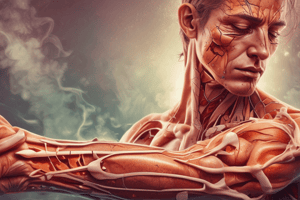Podcast
Questions and Answers
What type of nociceptor fiber is responsible for transmitting 'fast pain'?
What type of nociceptor fiber is responsible for transmitting 'fast pain'?
- D fibers
- B fibers
- C fibers
- Aδ fibers (correct)
Which of the following substances is NOT considered an algogenic substance?
Which of the following substances is NOT considered an algogenic substance?
- Epinephrine (correct)
- Histamine
- Substance P
- Acetylcholine
What effect does the release of algogenic substances have on blood vessels?
What effect does the release of algogenic substances have on blood vessels?
- Thickening of blood vessel walls
- Vasodilation and increased permeability (correct)
- No effect on blood vessels
- Constriction and decreased permeability
Which fiber type is characterized as larger and unmyelinated, transmitting slow, dull pain?
Which fiber type is characterized as larger and unmyelinated, transmitting slow, dull pain?
Which part of the nervous system is primarily responsible for transmitting signals from nociceptors to the brain?
Which part of the nervous system is primarily responsible for transmitting signals from nociceptors to the brain?
Nociceptors respond to which types of stimuli?
Nociceptors respond to which types of stimuli?
Which condition is NOT a trigger for nociceptors?
Which condition is NOT a trigger for nociceptors?
Flashcards
Nociceptors
Nociceptors
Nerve endings that respond to intense stimuli, transmitting pain signals.
Aδ fibers
Aδ fibers
Smaller, myelinated nerve fibers that transmit fast, localized pain.
C fibers
C fibers
Larger, unmyelinated nerve fibers that transmit slow, diffuse pain.
Algogenic substances
Algogenic substances
Signup and view all the flashcards
Histamine
Histamine
Signup and view all the flashcards
Bradykinin
Bradykinin
Signup and view all the flashcards
Pain Transmission
Pain Transmission
Signup and view all the flashcards
Study Notes
Pathophysiology of Pain
- Pain is a complex process involving three components: Peripheral nervous system (Afferent Pathways), Central Nervous System, and Descending Control system (Efferent Pathways).
Afferent Pathways and Nociceptors
- Nociceptors are nerve endings that respond to intense stimuli.
- All body systems, except large internal organs (viscera), contain nociceptors.
- Viscera pain is transmitted by other receptors in response to inflammation, ischemia, or stretching.
- Nociceptors are triggered by mechanical, thermal, or chemical stimuli.
- These stimuli are converted into electrical activity, known as action potentials.
- Action potentials are transferred to the dorsal horn of the spinal cord.
- From there, the signal is transmitted to the brainstem or thalamus.
- Two types of afferent nerve fibers are involved: Aδ and C fibers.
Aδ Fibers
- Smaller and myelinated
- Transmit signals rapidly, resulting in a precisely localized "fast pain" sensation.
C Fibers
- Larger and unmyelinated
- Transmit signals slowly, leading to a diffuse "second pain" sensation that is often described as dull, aching, or burning.
Pain Transmission
- When nociceptors are stimulated, histamine is released from mast cells.
- This triggers the release of algogenic (pain-causing) substances in the extracellular space.
- These substances include histamine, bradykinin, acetylcholine, serotonin, and substance P.
- These substances cause vasodilation (redness and warmth) and increased vascular permeability (swelling).
Studying That Suits You
Use AI to generate personalized quizzes and flashcards to suit your learning preferences.




